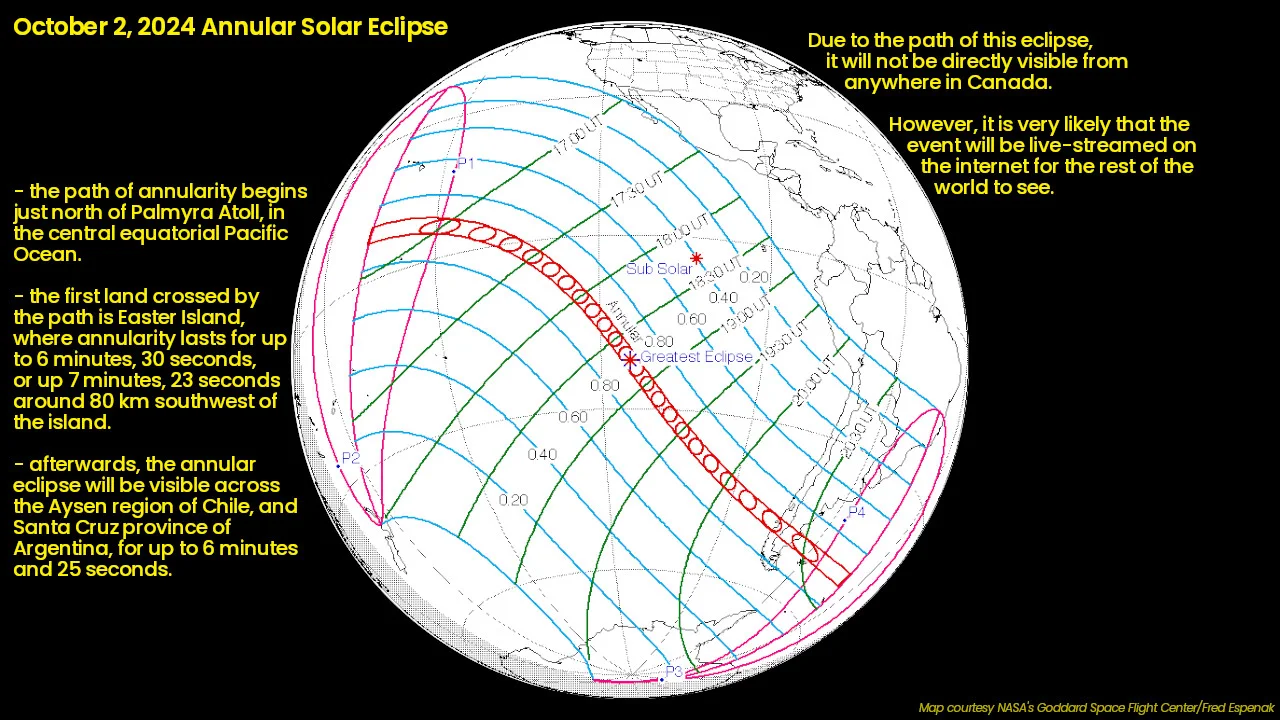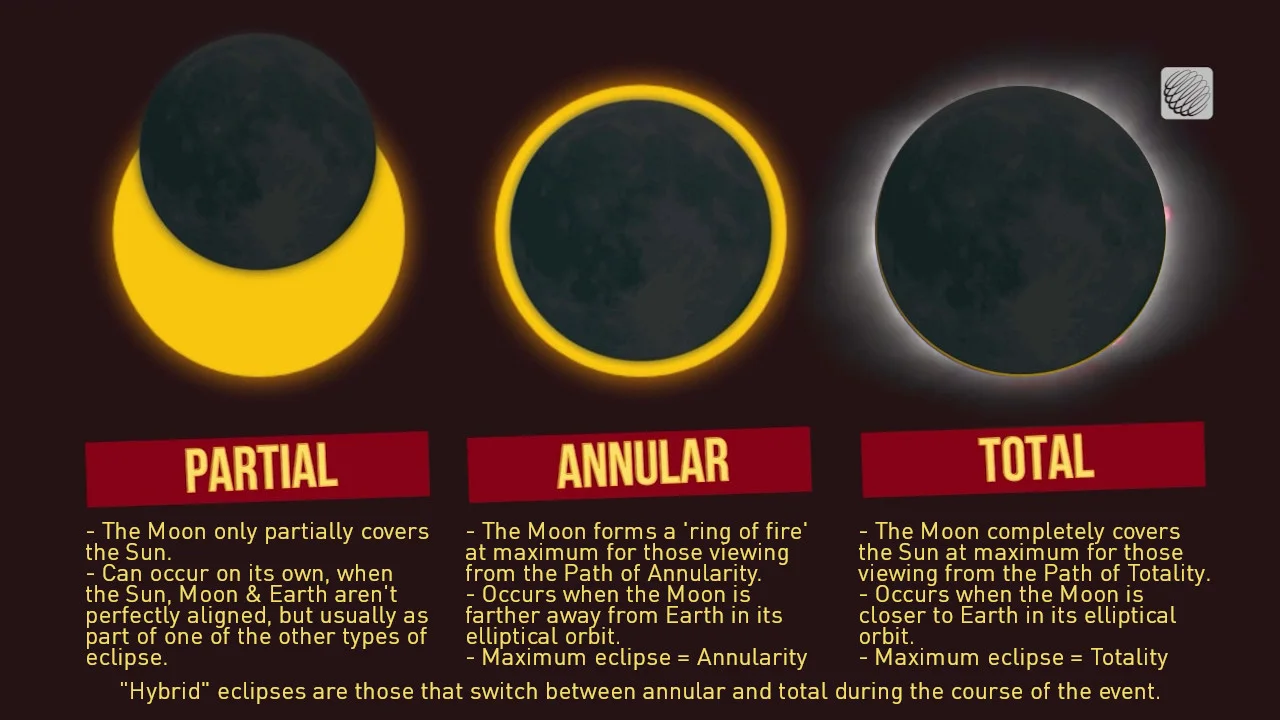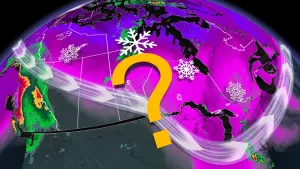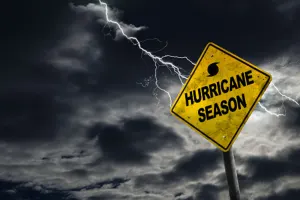
How to watch today's 'Ring of Fire' annular solar eclipse from anywhere
Canada won't see this event directly, but we still don't have to miss out!
The globe's second solar eclipse of 2024 takes place today, and while it is not directly visible in Canadian skies, there are still ways to watch this spectacular astronomical alignment.
On Wednesday, October 2, 2024, we're in for a treat. On that day, the Sun, the Moon, and the Earth will all line up in a perfect arrangement to produce a solar eclipse.

An annular or 'ring of fire' solar eclipse is visible here, framed above and below by scattered, orange tinted clouds. (NASA's Goddard Space Flight Center)
Unlike the April 8 total solar eclipse, where the Moon completely blocked the Sun's disk for a short period of time, this event will be an annular, or 'ring of fire', eclipse. Also, while the April eclipse passed over North America, from Mexico to Atlantic Canada, this event will be focused on the southern hemisphere.
A brief partial solar eclipse can be seen from parts of Baja California and a tiny sliver of the southern Mexico coastline early on, but otherwise the eclipse will be visible across the south Pacific Ocean and South America.

Even though we, here in Canada, will not be able to simply look up and witness this eclipse for ourselves, we can still watch it.
Starting at 1:15 p.m. EDT on Wednesday, timeanddate.com will be live streaming the annular solar eclipse with views from Easter Island and parts of southern Chile and Argentina.
Livestream: Watch the October 2 ring of fire solar eclipse from the southern hemisphere
Locations across the South Pacific Ocean and South America that are outside the path of annularity during this event will see a partial solar eclipse.
READ MORE: Was that a solar flare? What did we see during the April 8 total solar eclipse?
Annular vs Total Eclipses
Why is this eclipse so different from the one earlier this year? It all has to do with the Moon's position in space as it passes between the Earth and the Sun.
In April, the eclipse occurred when the Moon was closer to Earth in its elliptical orbit. As such, it appeared big enough in our sky to cover the Sun completely. However, on Wednesday, the Moon will be more than 46,000 kilometres farther away from us than it was on April 8. As such, it will appear smaller to us than it did six months ago, and as a result, it will only be able to cover most of the Sun's disk as it passes between the Sun and Earth.

The April 8 New Moon and October 2 New Moon are shown here, side by side for comparison. With the Moon 359,781 km away on Apr. 8, vs 406,515 km on Oct. 2, it appears smaller in our sky now, and thus can only cover most of the Sun's disk during this eclipse. (NASA's Scientific Visualization Studio/Scott Sutherland)
Meanwhile, the eclipse has changed position from the Northern Hemisphere to the Southern Hemisphere due to the exact timing of the event in relation to where the Moon is in its orbit.
As the Moon travels around Earth, the orbit it follows is tilted, both with respect to Earth's equator and with respect to Earth's orbit around the Sun. The orientation of this tilt changes, as well, wobbling back and forth as we move through space and time.

Four views of the Earth-Moon system show the tilt of the Moon's orbit. In the upper left frame, the Moon is at a high enough angle that its shadow passes over Earth's north pole (left), while at upper right, the Moon is low enough that its shadow passes over the south pole. No place on Earth sees a solar eclipse at these two times. In the lower two frames, the Moon is closer to the 'centre' of its tilt, and thus its shadow sweeps across the face of Earth during the New Moon. (NASA's Scientific Visualization Studio/Scott Sutherland)
As shown above, most times, the Moon's shadow passes by either above or below the planet. Roughly twice a year, though, the angles work out much better and the shadow sweeps over the planet's surface. Due to the differences in the timing, the shadow follows a different path, and affects a different part of the world, each time.
In addition, when all of these differences in distance, timing, and position are combined, we also end up with three different types of solar eclipse.

While 2024 has both a total and an annular solar eclipse, according to NASA, we're going to have to wait until 2026 for the next ones. The Sun and Moon aren't completely skipping over 2025 for eclipses, though. Two are expected, one on March 29 and another on September 21, 2025. However, both of those will only be partial solar eclipses.
The next annular solar eclipse occurs on February 17, 2026, with the path of annularity passing over eastern Antarctic. The next total solar eclipse will be on August 12, 2026, which will be visible from northeastern Greenland, Iceland, the north Atlantic Ocean, and parts of southern Europe.










